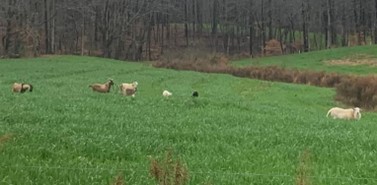 Winter grazing for livestock offers numerous benefits that extend beyond traditional feeding practices. This article explores the advantages of winter grazing, including improved animal performance, enhanced animal health, reduced labor for farmers, and ultimately, improved profitability.
Winter grazing for livestock offers numerous benefits that extend beyond traditional feeding practices. This article explores the advantages of winter grazing, including improved animal performance, enhanced animal health, reduced labor for farmers, and ultimately, improved profitability.
Improved Animal Performance:
Winter grazing allows animals to continue their natural behaviors which limits exposure to mud and pathogens that often occur at hay feeding stations. Research by Johnson et al. (2018, “Effects of Winter Grazing System on Cow Performance and Pasture Productivity”) demonstrates that properly managed winter grazing can maintain or even enhance body condition in livestock leading to improved reproductive performance and better weight gain.
Improved Animal Health:
Providing livestock with access to a variety of forages and the opportunity to graze during winter can positively impact their health. A study conducted by Smith et al. (2019, “Winter Grazing and Its Effects on Sheep Health and Parasitism”) found that winter grazing can reduce the risk of gastrointestinal parasitism in sheep due to the limited exposure to contaminated areas compared to confinement. Exercise is another benefit of winter grazing by maintaining muscle tone during pregnancy and reducing the risk of dystocia at lambing.
Reduced Labor for Farmers:
Implementing a well-designed winter grazing system can streamline labor requirements. A research article by Brown and Miller (2020, “Economic and Labor Considerations for Winter Grazing Systems”) emphasizes that properly planned winter grazing reduces the need for intensive feeding and manure management, freeing up valuable time and labor resources for farmers.
Improved Profitability:
Winter grazing can contribute to higher profitability through reduced feed costs and improved animal performance. The study by Chambers et al. (2017, “Economic Analysis of Winter Grazing vs. Confinement Feeding of Beef Cows”) indicates that well-managed winter grazing systems can lower feeding costs and potentially increase revenue through healthier animals and improved reproduction rates.
Our farm is located in the Piedmont region of Georgia and the following test site mixes were planted on September 1st. The Site 1 mix was a first for us. The only amendment utilized was Johnson Su Compost from Collville Compost. It was used as an inoculate on untreated seed.
Historically, our winter grazing mixes that have proven productive are Cosque Black Oats, Everleaf Oats, Crimson Clover, Marshall Rye Grass, and Hairy Vetch. We have had limited success with Brassicas, although at seeding rates of 1 pound per acre they are not much of a liability financially. We experimented with adding warm season annuals to the mix this year, but our ground cover was too dense and may have limited germination of these seeds. We have not had any success planting cool season annuals into fescue pastures, but we have had great success planting cool season annuals into Bermuda and crabgrass pastures. Overall, our sheep and our soils are healthier with the addition of cool season annuals into our pastures.
In conclusion, embracing winter grazing practices for livestock brings about a range of benefits, from boosting animal performance and health to easing labor demands on farmers and enhancing overall profitability. By utilizing insights from verified research articles, the evidence is clear: a well-executed winter grazing strategy can be a win-win for both livestock and farmers alike.
Site 1 Winter Grazing Plan (3 Acres)
30 lbs of Everleaf Oats (Fall Growth)
30 lbs of Cosaque Black Oats (Early Spring Growth)
5 lbs Albon Rye
5 lbs of Wheat
5 lbs of Vetch (Soil Improvement)
1 lb of Radish (Fall Growth)
1 lb of Kale (Fall Growth)
10 lbs of Sorghum Sudan
5 lbs of Sunflower
5 lbs of Buckwheat
5 lbs of cowpeas
Site 2 Winter Grazing Plan (3 Acres)
30 lbs of Everleaf Oats (Fall Growth)
30 lbs of Cosaque Black Oats (Early Spring Growth)
10 lbs of Red Clover
5 lbs of Buckwheat
1 lb of Turnips
Site 3 Winter Grazing Plan (3 Acres)
20 lbs of Everleaf Oats
20 lbs of Triticale
10 lbs of Elbon Rye
10 lbs of Wheat
3 lbs of Kale
By: Ryan Ayers, Sweet Shrub Farms, Carrollton, GA
Young Farmer Adviser, Carrol County Schools
![]()


